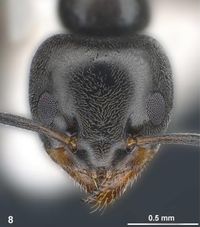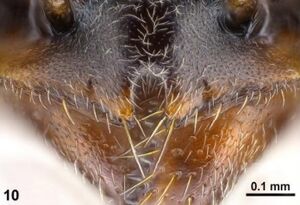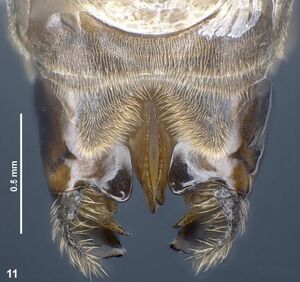Tapinoma darioi
| Tapinoma darioi | |
|---|---|

| |
| Scientific classification | |
| Kingdom: | Animalia |
| Phylum: | Arthropoda |
| Class: | Insecta |
| Order: | Hymenoptera |
| Family: | Formicidae |
| Subfamily: | Dolichoderinae |
| Genus: | Tapinoma |
| Species group: | nigerrimum |
| Species: | T. darioi |
| Binomial name | |
| Tapinoma darioi Seifert, D'Eustacchio, Kaufmann, Centorame & Modica, 2017 | |
A species that has an affinity for coastal habitats.
| At a Glance | • Supercolonies • Invasive |
Identification
A member of the Tapinoma nigerrimum complex.
Tapinoma darioi, which has a completely dark body, belongs to the T. nigerrimum complex that includes four species that have been recently described (Seifert et al., 2017). Furthermore, the depth-to-width ratio of clypeal excision and length-to-width ratio of second funiculus segment are on average larger than in the other species (Seifert et al., 2017; Hernandez-Teixidor et al., 2020).
Keys including this Species
Distribution
Seifert et al. (2017) - Tapinoma darioi is found in northeast Spain, the Balearic islands, southern France, Corsica, and northwest Italy south to Rome in an area delimited by 39.8° N, 44.2° N, 0.1° W, and 12.4° E.
This ant is originally from the Mediterranean basin, showing preference for coastal areas (Seifert et al., 2017). Outside its native area, it had been introduced only in the Netherlands (Guénard et al., 2017). On Tenerife, Canary Islands, it has only appeared in one locality in a greenhouse in Valle de La Orotava (Hernandez-Teixidor et al., 2020). We found individuals of this species together with others of Pheidole pallidula in a group of olive trees introduced from the Iberian Peninsula, where both species are very common in olive groves (Moreno-García, Reyes-López, Repullo-Ruibérriz de Torres, & Carbonell-Bojollo, 2017; Hernandez-Teixidor et al., 2020).
Latitudinal Distribution Pattern
Latitudinal Range: 51.98° to 36.72°.
| North Temperate |
North Subtropical |
Tropical | South Subtropical |
South Temperate |
- Source: AntMaps, Seifert et al. (2024)
Distribution based on Regional Taxon Lists
Palaearctic Region: Balearic Islands, France, Italy, Spain (type locality).
Distribution based on AntMaps
Distribution based on AntWeb specimens
Check data from AntWeb
Countries Occupied
| Number of countries occupied by this species based on AntWiki Regional Taxon Lists. In general, fewer countries occupied indicates a narrower range, while more countries indicates a more widespread species. |

|
Estimated Abundance
| Relative abundance based on number of AntMaps records per species (this species within the purple bar). Fewer records (to the left) indicates a less abundant/encountered species while more records (to the right) indicates more abundant/encountered species. |

|
Biology
Seifert et al. (2017) - In contrast to T. magnum, there is a clear preference for coastal areas: 32 samples were taken along the shore line within a maximum distance of 4 km from beach and seven samples more than 4 km behind shore. This is significantly different from a homogenous distribution over shoreline and inland (Fisher's exact test p = 0.0054). With 16 sequences belonging to 10 haplotypes, T. darioi is more diverse in southern France than in Italy where 11 investigated sequences belonged to only two haplotypes. This suggests a radiation center of this species in southern France. A disjunct, northern population at Chalon-sur-Saone (46.78° N, 4.86° E) and the introduction to Wageningen (51.98° N, 5.67° E) indicate a tramp species potential.
Nest construction and the build-up of an impressive network of deeply excavated trails in coastal dune habitats is the same as in Tapinoma magnum. The information on biology given by Xerda & al. (1989) could be referred to T. darioi by geographic indication. Foraging in northeast Spain is diurnal from February to May and crepuscular and nocturnal from June to November. Very extensive trophobiosis with aphids occurs both on high trees and in the herb layer – honey dew accounts for probably > 80% of total food mass. Consumption of nectar, elaiosomes of diverse myrmecochorous plants and of fallen sweet fruits is less important. Carnivory of insects, snails and spiders is significant but probably more a collecting of carcasses than active hunting. Predation of sexuals of ants alighting after nuptial flight may be intensive. After discovery of very large food items, a mass recruitment starts. The item is disintegrated and the cut-off pieces are retrieved by single workers. Cooperative transport of items is so far unknown. Xerda & al. (1989) also observed a tool use: Small twigs or pebbles are dropped into liquid food and retrieved after impregnation. The phenology of sexual production is poorly studied but apparently comparable to the situation in T. magnum: 22 May ± 20 d [23 April - 23 June] n = 12. There is one observation of alates from France 16 September 2014. One flight observed in Wageningen / Netherlands took place 9:23 h ST on 31 May 2014 (11:00 h Cest according to Noordijk (2016), adjusted to solar time ST). Foraging time and temperatures of the Wageningen population are comparable to observations in German T. magnum: last activity was in late December at air temperatures of 3 °C (cloudy day) or -2 °C (sunny day) and activity was resumed by the end of February at 6 °C (Noordijk 2016).
Supercolonies have the same extension as in Tapinoma magnum and probably also the same demography and competitive power: a very large supercolony at La Grande Motte, being more than 200 m long, had occupied in 2012 just the area covered by a huge colony of Linepithema humile ten years ago.
Tapinoma darioi has never been recorded as invasive, except in the Canary Islands (Hernandez-Teixidor et al., 2020) and a possible case in the Netherlands (Seifert et al., 2017). Other species within the complex, such as T. magnum, have a considerable invasive potential (Seifert et al., 2017).
Castes
Worker

| |
| . | |
Male

| |
| . | |
Nomenclature
The following information is derived from Barry Bolton's Online Catalogue of the Ants of the World.
- darioi. Tapinoma darioi Seifert, D'Eustacchio, Kaufmann, Centorame & Modica, 2017: 141, figs. 8-11 (w.m.) ITALY.
Unless otherwise noted the text for the remainder of this section is reported from the publication that includes the original description.
Description
Worker
Significantly smaller than the other three species of the Tapinoma nigerrimum complex; CW 859 ± 158 [559, 1189] μm. Depth-to-width ratio of clypeal excision and length-to-width ratio of second funiculus segment on average larger than in the other species: ExCly / ExClyW 1.609 ± 0.265 [1.115, 2.289] and IFu2 1.948 ± 0.114 [1.679, 2.289]. Mandibles with a large apical, a less large subapical, and 9 - 11 smaller teeth homogenously distributed over the whole masticatory margin. Whole head (except for clypeus) and dorsum of mesosoma always without standing setae. Long standing setae are present on the fourth gaster tergite (rarely beginning at the 2nd), on all gaster sternites, the ventral surfaces of hind and middle coxae and the frontal and caudal face of fore coxae. Anterior margin of clypeus with several setae; the two longest and strongest are inserted at anterior corners of clypeal excision. All body surfaces with the exception of mandibles covered by an appressed, rather dense pubescence; mean distance of insertion points of pubescence hairs on central vertex of a major worker 8.5 μm. Pubescence on frontomedian vertex and clypeus more subdecumbent with 6 to 19 pubescence hairs protruding at a few micron across margin of clypeal excision. Whole body dark to blackish brown except for reddish brown or yellowish mandibles, anterior clypeus, and distal and proximal ends of tibiae in many major workers.
Male
On average smaller than in the other three species of the Tapinoma nigerrimum complex. Data of 29 individuals: CW 1.028 ± 31 [972, 1121] μm, CL / CW 0.908 ± 0.021 [0.871, 0.961], SL / CS 0.957 ± 0.026 [0.901, 1.023], ExClyW / CS 6.83 ± 1.06 [4.15, 9.39] %, ExClyW / CS 6.96 ± 0.89 [4.27, 8.83] %, dAN / CS 0.286 ± 0.008 [0.265, 0.302], EL / CS 0.322 ± 0.009 [0.300, 0.338], ML / CS 1.847 ± 0.059 [1.727, 1.976], Fu2 / CS 25.44 ± 0.72 [23.86, 27.35] %, IFu2 2.692 ± 0.129 [2.387, 2.910], ExBasi / CS 6.62 ± 0.93 [4.68, 8.93] %, WSPL / CS 23.65 ± 3.14 [16.5, 29.9] %, ALPH 60.0 ± 6.7 [44, 71] °. The genital shows in ventral aspect a very broad basimere and a broad blade-like harpago which separates very well from members of other species complexes. However, genital morphology does not offer eye-catching differences to the other species of the T. nigerrimum complex. A sufficiently clear species delimitation is only possible by multivariate analyses which consider both genital and extragenital characters.
Type Material
Holotype, a major worker on the same pin with three paratype workers, labelled "ITA: 41.69858°N, 12.34985°E, Roma, Castelporziano, 1 m, Grotta di Piastra, dune, D’Eustacchio 20140423-TLa45", "Holotype (top specimen) and paratypes Tapinoma darioi SEIFERT & al."; two paratype gynes and two paratype males on other pins with the same collecting data. Another two pins with 8 paratype workers from a nest situated 240 m east, labelled "ITA: 41.69823°N, 12.35240°E, Roma, Castelporziano, 13 m, Tor Paterno parcel, dune, under shrub, D'Eustacchio 20130614-TLa27". All material stored in SMN Görlitz.
Etymology
The new species is dedicated to Dario D'Eustaccio who has been a major protagonist in this project but did not experience its completion due to his tragic death.
References
- Bulter, I. 2020. Hybridization in ants. Ph.D. thesis, Rockefeller University.
- Hernández-Teixidor, D., Pérez-Delgado, A.J., Daniel Suárez, D., Reyes-López, J. 2020. Six new non-native ants (Formicidae) in the Canary Islands and their possible impacts. Journal of Applied Entomology 00:1–8 (doi:10.1111/jen.12751).
- Schifani, E. (2022). The new checklist of the Italian fauna: Formicidae. Biogeographia – The Journal of Integrative Biogeography 37, ucl006 (doi:10.21426/b637155803).
- Seifert, B., D'Eustacchio, D., Kaufmann, B., Centorame, M., Lorite, P., Modica, M.V. 2017. Four species within the supercolonial ants of the Tapinoma nigerrimum complex revealed by integrative taxonomy (Hymenoptera: Formicidae). Myrmecological News, 24, 123-144.
- Seifert, B., Kaufmann, B., Fraysse, L. 2024. A taxonomic revision of the Palaearctic species of the ant genus Tapinoma Mayr 1861 (Hymenoptera: Formicidae). Zootaxa 5435(1), 1-74 (doi:10.11646/zootaxa.5435.1.1).
References based on Global Ant Biodiversity Informatics
- Seifert B. D. D'Eustacchio, B. E. Kaufmann, M. Centorame, and M. Modica. 2017. Four species within the supercolonial ants of the Tapinoma nigerrimum complex revealed by integrative taxonomy (Hymenoptera: Formicidae). Myrmecological News 24: 123-144.
